As of last Sunday, August 14, 76% of Nebraska’s corn was rated in good to excellent condition, according to USDA-NASS and crop development was outpacing last year and the previous five-year average. In most cases corn yield forecasts for Nebraska (Aug. 10 UNL Forecasts and Aug. 12 USDA–NASS forecast) and the U.S. are somewhat encouraging. However, critical seed-fill stages remain and as the old saying goes, “The proof in the pudding is in the eating!” Cool evening temperatures during seed fill and a late frost could ensure higher yields. Experiencing the opposite conditions, however, wouldn't be so good.
Nevertheless, amidst all the optimism are widespread reports from many individuals of ear formation issues. These reports range from Gothenburg to Saunders County and south to Kansas with numerous reports in Clay and Thayer counties. It’s important to look at fields now prior to harvest to determine any potential issues before the combine goes through the field. This article describes and discusses what we know about the situation, potential stress agents, and the development of corn. Here are the three types of symptoms we’re seeing and/or hearing about:
- Short husks – normal ear length
- Dumbbell-shaped ears
- Multiple ears per node
Short Husks – Normal Ear Length
Symptoms: Shortened husk leaves with normal ear protruding beyond the husks (Figure 1). Indeed ears of some hybrids often protrude a bit beyond the husk leaves – some suggest this aids in dry-down. However, the symptoms we’re discussing here are more severe. In these situations, ears outgrow husks by one-third to one-half (Aldrich et al. 1986). Based on our observations this year, the primary ear was aborted in most, if not all, situations. Thus, these ears are predominantly secondary ears.
Incidence: Common in some fields with some hybrids.
Developmental Timing: Likely resulting from stress prior to tasseling, VT, but before the blister stage, R3. Aldrich et al., 1986, observed this where “… extreme [drought] prevailed during the time of ear set with abundant rainfall and good growing conditions thereafter.” These symptoms tell us something about corn ear development: husk leaf elongation must precede ear elongation and thus, husk elongation was subjected to stress at a critical time. In these cases, when the stress was alleviated, the ear grew at a normal rate and to a normal length.
Potential stress agent and interacting factors: Bob Nielsen, corn agronomist at Purdue University, states (from the reference listed below), “…The development of stunted husk leaves and exposed ears seems to be related to a combination of severe stress before or during pollination that is then relieved in the initial weeks following pollination. The most common combination of conditions that results in this oddity is severe heat and drought stress that is then relieved by cooler temperatures and rainfall.” In our current situation we think high June temperatures, followed by a cool spell in very early July which was followed by more high temperatures and the high winds associated with the July 7 storm not only affected primary ear formation/abortion, but also suppressed husk elongation rates.
Potential consequences: Kernels are exposed to bird/insect feeding and other damage. This could result in fungal infection, ear molds, and potentially discounted grain price.
References
- Short Husks and Exposed Ears, R.L. (Bob) Nielsen, Purdue University, https://www.agry.purdue.edu/ext/corn/news/timeless/EarHusks.html
- Modern corn production, S.R. Aldrich, W.O. Scott, and R.G. Hoeft. 1986. A&L Publications, Champaign, Ill.
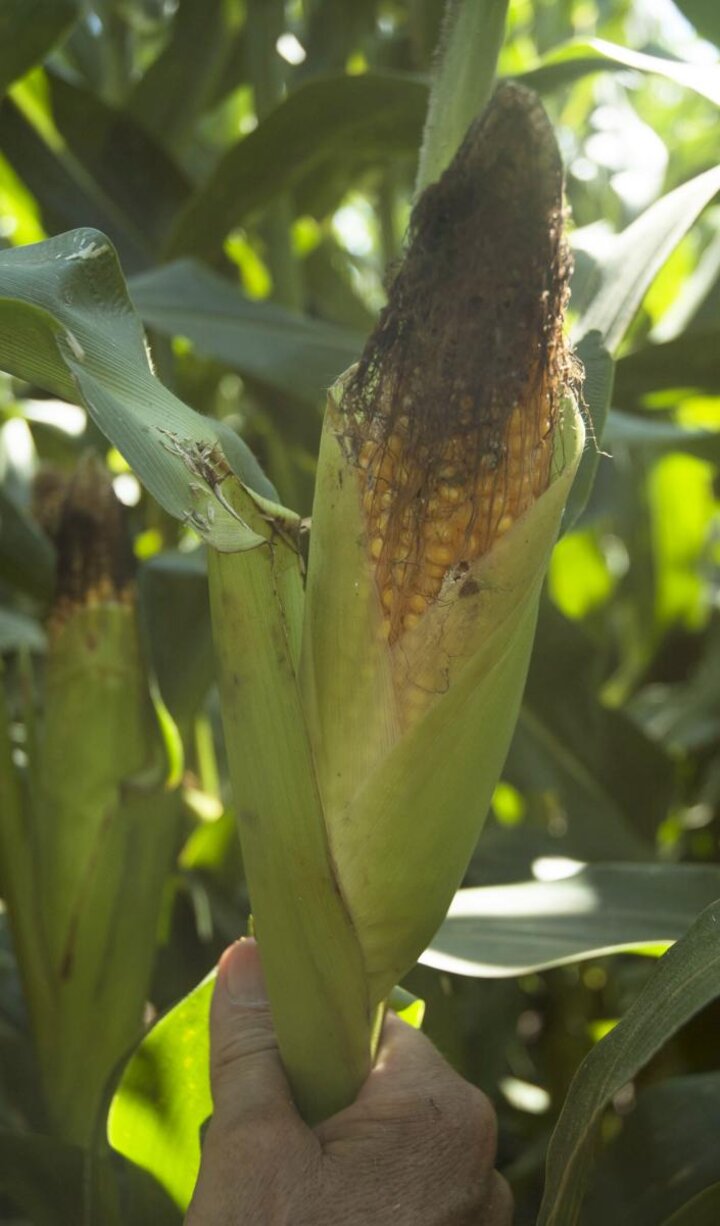



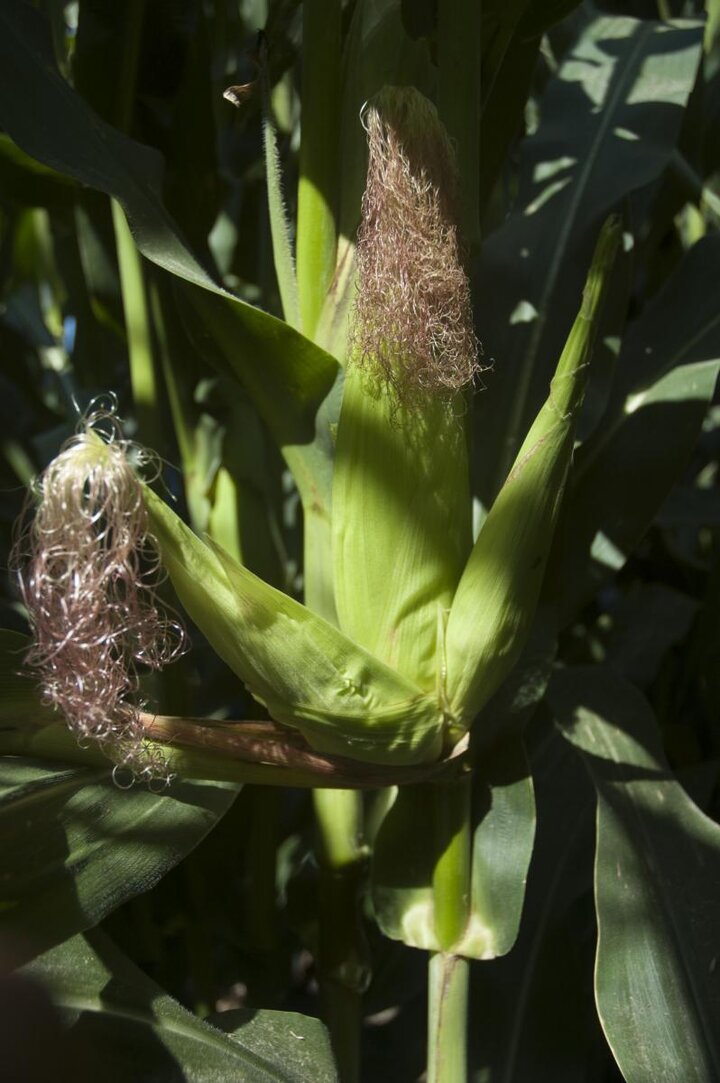
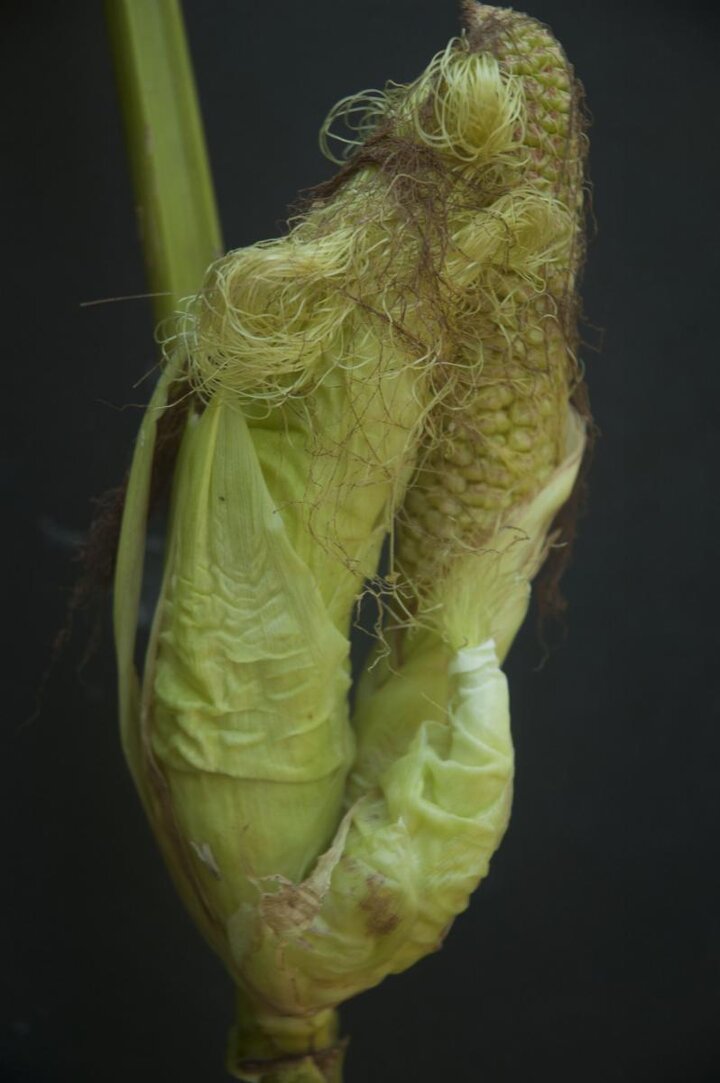
Dumbbell-Shaped Ears
Symptoms: Kernels may form at the tip or the butt of the ear, or at both locations but not in mid ear (Figure 2). Based on our observations the primary ear was aborted in most if not all situations. Thus, these ears are predominantly formed at nodes below the primary ear node.
Incidence: Common in some fields with some hybrids.
Developmental timing: Ohio State University suggests this is triggered during ear formation (see reference below). Our observations, when coupled with work at Iowa State University (see Abendroth et. al. 2011) fine tune that general timing to the period from V12 to perhaps V15, just prior to tasseling (VT).
Potential stress agent and interacting factors: According to Ohio State, “This problem is associated with chilling injury during ear formation and more evident in certain sweet corn genetic backgrounds. Low temperatures disrupt normal kernel development resulting in anomalous ear growth.” (From Ohio State University reference listed below.) We agree that low temperatures mentioned in the last section may have contributed, however, we are certain that the high winds of July 7 which followed good growing conditions were an overriding factor as well as the loss of the primary ear.
Potential consequences: Reduced yield per plant and depending on extent, reduced yield over the entire field.
References
- Troubleshooting Abnormal Corn Ears: Barbell Ears http://u.osu.edu/mastercorn/bar-bell-and-bear-claw/
- Corn growth and development. Abendroth et al. 2011. Iowa State University Extension. https://store.extension.iastate.edu/product/Corn-Growth-and-Development
Multiple Ears Per Node
Symptoms: Multiple ears per node, also known as bouquet ears (Figures 3 and 4). Based on our observations, the primary ear was aborted in most if not all situations. Thus, these ears are predominantly secondary ears.
Incidence: Varied, depending on location and hybrid.
Developmental Timing: Late vegetative (V12- V15), pre-tassel development stages.
Potential Stress Agent and Interacting Factors: In almost all cases where we’ve seen this, the primary ear never developed. (See Iowa State University reference listed below.) Our hypothesis is that when the primary ear was aborted or failed to develop, apical dominance was lost and that loss triggered development of the secondary node. As Bob Nielsen (Purdue) stated in a recent email, “We know from past experiences with this phenomenon that some hybrids seem particularly prone to “releasing” the normal hormonal suppression of the axillary meristems on the ear shank when the primary is damaged or fails to successfully pollinate.” We know that the ear shank is a “mini stalk” and when apical dominance is lost or weakened, ears can develop on shank nodes… thus, multiple ears per node.
The question is why? Temperature extremes earlier in the season could be responsible as suggested above. Certainly stress like the wind we had could disrupt the primary ear. But, in 2006, there were clear hybrid differences and no clear stress agent or event so it’s likely a hybrid-specific stress response. The earlier cool spell followed by good growing conditions coupled with the strong winds on July 7 could have damaged the primary ear.
Potential consequences: Reduced yield per plant and depending on extent, reduced yield over the entire field.
References
- Multiple ears per node: Iowa 2006 situation and hypothesis, Roger Elmore and Lori Abendroth, http://crops.extension.iastate.edu/corn/production/management/mid/multiple.html
- A Problem with “Bouquets,” R.L. (Bob) Nielsen, Purdue University, https://www.agry.purdue.edu/ext/corn/news/articles.06/Bouquets-0912.html
Overriding Conclusions
- The main observation that seems to cut across all these symptoms is the loss of the primary ear node (Figure 5).
- The issues all appear to be hybrid specific. The hybrids affected reportedly are offensive, race-horse hybrids.
- The widespread nature of the symptoms suggest a weather-related stress event such as the July 7 windstorm which followed a cool spell and then a period of hot weather (Figure 6). The co-association with green snap and lodging seems to substantiate this. Most Nebraska corn was in late vegetative stages on July 7.
- Poor pollination on some of these ears may be due to the primary ear being aborted during the critical pollen shed period and the secondary or tertiary ears not receiving pollen and/or the silks being constrained by tight husks where ear pinching occurred.
- It’s very important that you get out and look at your fields prior to harvest so you are not surprised when the combine goes through the field. It is very difficult to assess what happened to yield after the field is combined.
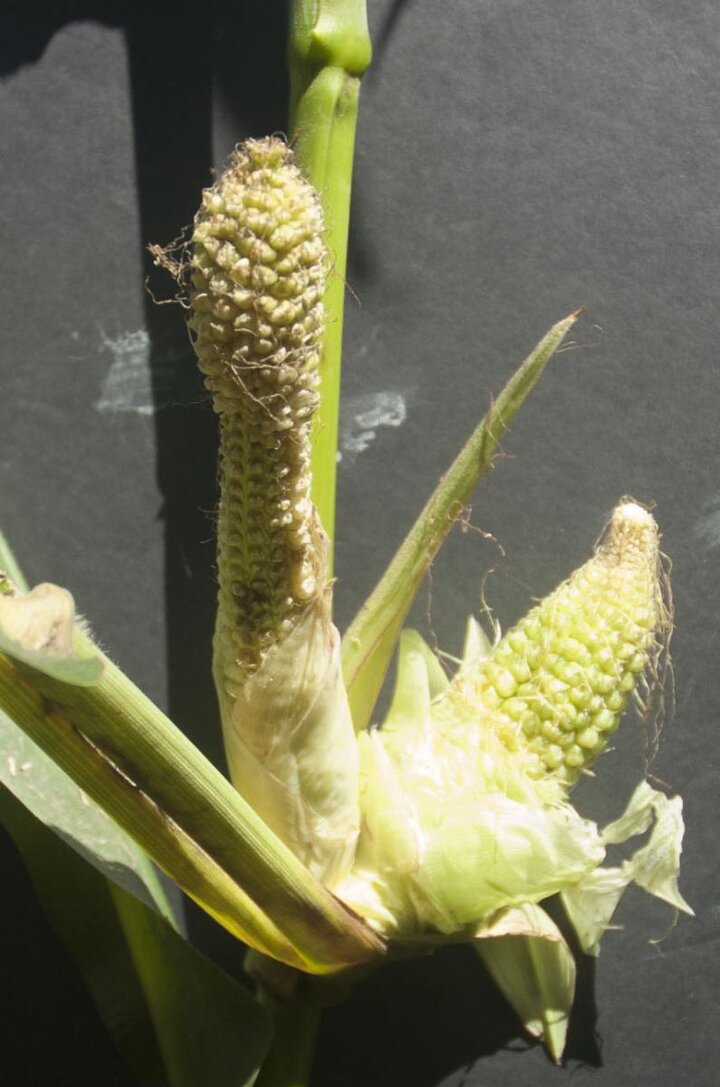
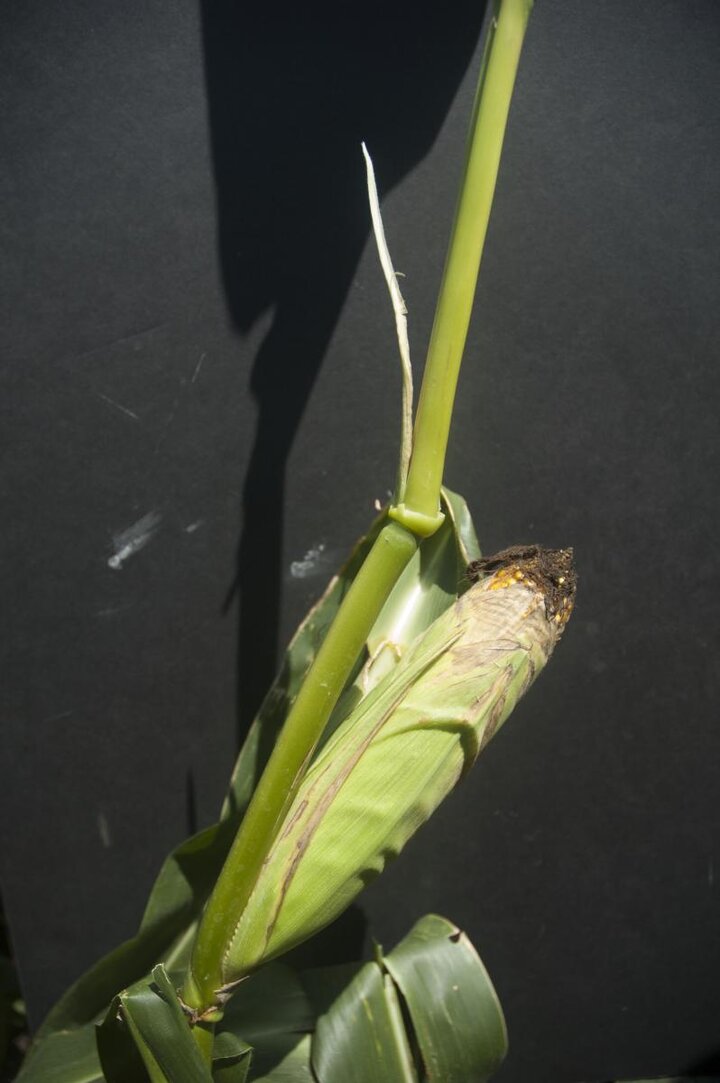

Our Next Steps
We will be:
- Summarizing weather data in the area impacted.
- Conducting intensive plant to plant sampling, observations, and yield in affected areas.
- Keeping you up to date on our findings.
Questions To Ask If You Your Corn has Ear Formation Issues Like These
Are there patterns of hybrids, planting dates, populations, nitrogen/water stress, herbicide chemistries, surfactants and timing, fungicide and surfactants and timing, green snap or other weather-related events that are consistent across fields? Also, it’s important to determine if the remainder of the plant appears "normal" to narrow this down to only ear development damage.
How you can help us and hopefully others?
If you observe ear formation issues like these, please contact one of us:
- Roger Elmore, Extension Cropping Systems Agronomist, roger.elmore@unl.edu, 402-472-1451
- Jenny Rees, Extension Educator, jenny.rees@unl.edu, 402-440-4739
- Justin McMechan, Crop Protection and Cropping Systems Specialist, amcmechan2@unl.edu, 402-472-8653
- Tamra Jackson-Ziems, Extension Plant Pathologist, tjackson3@unl.edu, 402-472-2559
- Tom Hoegemeyer, Adjunct Professor of Practice, thoegemeyer2@unl.edu
